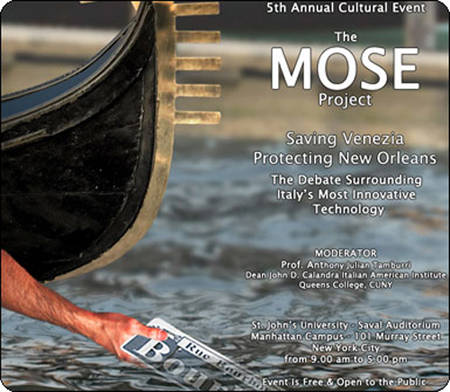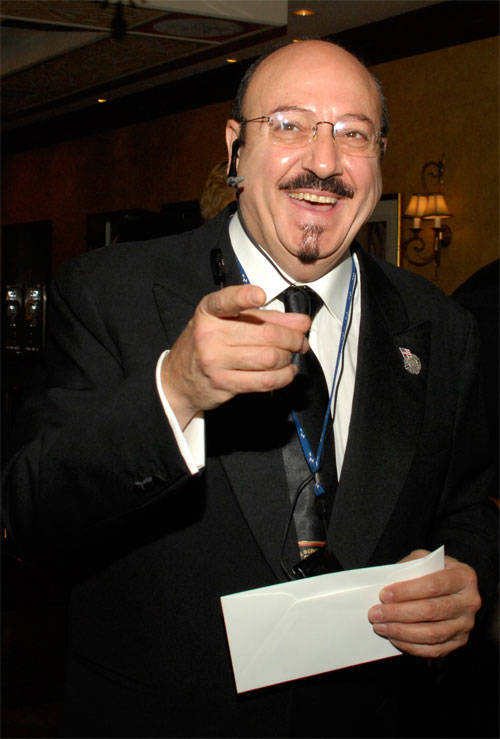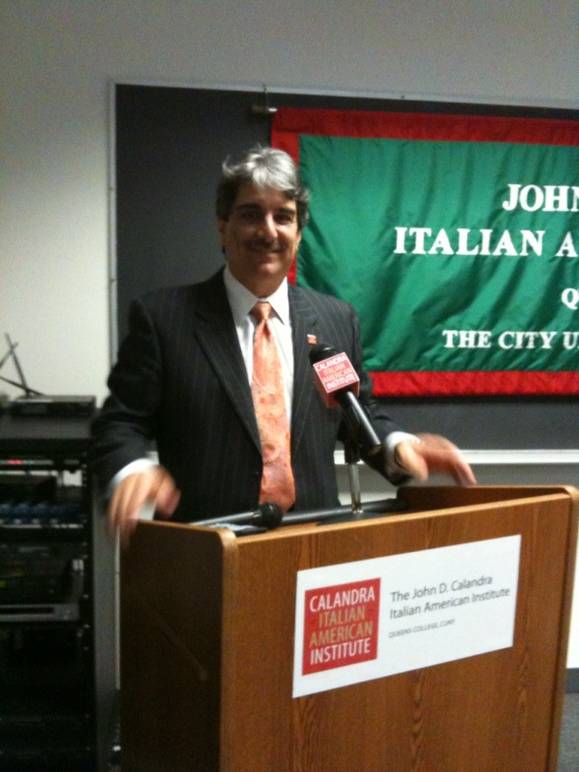"Saving Venezia & Protecting New Orleans." Introducing the MOSE Project
On September 25th a day-long internations conference in New York will be dedicated to the subject “SAVING VENEZIA & PROTECTING NEW ORLEANS.” Organized by ILICA (Italian language Inter-Cultural Alliance), the conference brings together scientists, academics, and experts from Italy and the U.S. to discuss MO.S.E. (acronym for Modulo Sperimentale Elettromeccanico, or Experimental Electromechanical Module)—a high-tech project intended to protect the city of Venice from floods through rows of electronically operated mobile gates.
“MO.S.E.” —the name is also a play on the Italian name for Biblical prophet Moses, Mosè—has been underway since the early 2000s and is entirely based on technology developed in Italy. In this conference the organizers suggest that MO.S.E. technologies could be of interest also to those who, in America, are studying how to protect the New Orleans bay from problems that have some similarities with those of Venice.
Before and during the conference, i-Italy will be publishing a series of reports and interviews about this event and its scientific and cultural background. We start today by interviewing Cav. Vincenzo Marra, President of ILICA and organizer of the event, and Professor Anthony Julian Tamburri, Dean of the John D. Calandra Italian American Institute (Queens College, CUNY) and president of the American Association of Teachers of Italian (AATI,) who is sponsoring the initiative.
Q: You have conceived a rather unusual gathering open mainly to scientists, experts, and academics... This is hardly the typical composition of many Italian-American events that people are mostly familiar with. What motivated your choice?
VINCENZO MARRA: We want to contribute to make Italy known in the US not only through folkloristic images and gala dinners...The XX Century image of Italy was the result of all the stories represented especially by images contained in "The Godfather". Since 1967, the year when more Italians went back to Italy from the USA than viceversa, the quality of the new Italian immigration in the USA, gave some of the best intellectual contributions to American social, financial, and academic world. From ISSNAF to NOVA, I could give an endless list of new Italian young professional associations in the USA. Somehow, someone must create a new paradigm for the new Italians.
ANTHONY J. TAMBURRI: We need to go beyond the "Three Fs" (Food, Fashion, and FIlm). The conference brings together Italian and American voices from the realm of science, for sure. But it also transcends the specifics in that it gives rise to a sort of epistemological comparison and/or exchange in how we receive and perceive certain modes of knowledge. In addition, especially with the inclusion of film makers, we witness the initial steps of how science is also employed in a cultural sense insofar as the fictional film project “Watermark” uses the geological challenges of the Venetian lagoon as a backdrop to a feature film.
Q: Why did you pick this particular subject? It is also a rather “controversial” subject...
VM: I see no risks in this. Italy is one of the G8 countries, it has often been at the helm of change, innovation and creativity and not only in the arts and culture, but also in technology. The world must know what MOSE is... Furthermore, the social evolution called today "Globalization", is redefining the social economical map of the world. Italy is geographically a small country however, in the 1700s, the Italian language was spoken by more people than those who speak English today. It is time for Italy to remember also the art of communication. By thinking always with politics in mind, we will be talking for the rest of our existence while the rest of the world will be more and more interested in what we do rather than what we say.
AJT: We tend to forget about Italy's contributions in the scientific and technological fields. Instead of thinking back to an Italy that no longer exists (the images of the poverty-stricken mountain villages,) we want to emphasize that Italy is indeed an historical source of science and technology as proven by the numerous Nobel Peace Prize winners over the years in the sciences. Furthermore, Italy is indeed a cultural source. It is the country of a language and culture that have given to Civilization the roots of modern western poetry (Dante and Petrarca), the template for what we call Modernity (the philosophy and art of the Italian Renaissance), and the matrix for our own modern-day legal philosophy (Cesare Beccaria).
Q: Why is it that the best known areas of Italian excellence seem limited to the “made in italy” phenomenon, especially in the gourmet and fashion industries?
AJT: Italian Americans too have a responsibility in this. As a community we seem to rely too much on the popularized images of Italy, be they steeped in the nostalgia of an Italy of long ago, be they steeped in the more controversial images that many feel do not promote the Italian/American causes in any manner of speaking. Indeed, then, we appreciate the effort made by ILICA to bring something different to the fore that, first, situates us in a different intellectual mode and, second, forces us to look at an Italy not all that familiar to the Italian/American community at large.
VM: The inspiration of Ilica is based on Vincenzo Sellaro, the founder of the OSIA in 1905. That was a major change and was very much needed. After 100 years we need the same kind of momentous change. This is only the first step. ILICA intends to be a catalyst for a new kind of Italian who come to the US not out of need but by choice... Those Italians need to be integrated into a multi ethnic, inter cultural society. As we need to know where we come from, we must finally start telling the world where we are heading. And, forgive me for saying so: we have so much more to offer than what we have achieved during the last century. We must create a synergy between tradition and XXI century Italians.
Q: How do we go about building a bridge between these two different realities: the descendants of those Italians who came “out of need” and today’s Italians who are coming “by choice”?
AJT: There is a new concept of migration today (not e-migration or im-migration) It's a new global mobility, and Italians are again in the forefront of these new developments... In my graduate class in Florida I had at least 5 students who came from Italy to study Italian/American culture as either a primary or secondary field, and some of them have remained in the US, they have children now who are Americans. Indeed, at least two of the particpants in this conference have had an experience analogous to my graduate students; they grew up in Italy, came to the United States at one point earliy in their post-laurea years, and they remained. It is a culturally constructive “contamination” between the two worlds that needs to be understand better, more profoundly, so that we can better appreciate our cultural heritage. This is the necessary inter-cultural discourse between Italy and America in which we all need to engage. This is one of the promises of this conference and one of the primary reasons I signed on to it.
VM: Indeed the ILICA acronym has this "Inter-Cultural" element in it, that tries to speak to a global world. And actually we have not forgotten about other areas of excellence such as food... we are flying in two great chefs to work with Andrea Tiberi... and also 2000 pounds of fresh fish from the Adriatic sea, which is so different from the one you find in the Atlantic... That is to make a point: the Italians who come here by choice are complementary to those who came here out of need. Italy must learn more about the Italian American experience and the Italian Americans must learn more about Italy today. We must recuperate the time we wasted by ignoring each other for too many years. Then we should help each other to enter the inter cultural society with an open mind. If an Italian American likes the Romano cheese on his fish salad, the Italian must recognize that as a different taste approach. We all use the "duck sauce" everywhere in the Chinese restaurant and I know that Chinese people don't even use that sugar taste in their food...However in the processing of globalization is more important to learn that one out of five chairmen of corporate America is of Italian origin.






































i-Italy
Facebook
Google+
This work may not be reproduced, in whole or in part, without prior written permission.
Questo lavoro non può essere riprodotto, in tutto o in parte, senza permesso scritto.